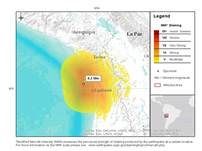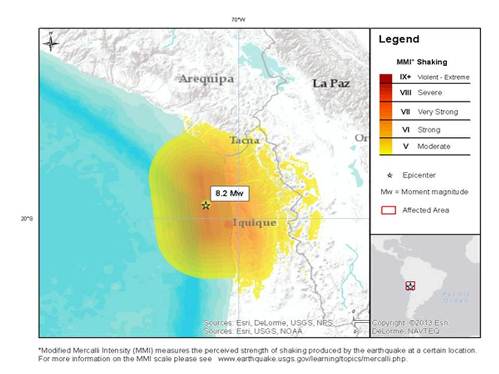

An 8.2-magnitude earthquake was reported by the U.S. Geological Survey (USGS) about 40 miles off the northern coast of Chile yesterday evening. More than 60 aftershocks were reported following the initial event, one of which was measured of magnitude 6.2. Shaking was felt as far away as La Paz Bolivia, over 290 miles (470 km) away.
A tsunami with waves up to 6.9 ft (2.1 m) was reported affecting the northern coast of Chile. City streets were inundated and fishing boats were affected, but no major tsunami damage was apparent. Tsunami warnings for the area have been lifted, yet advisories remain in place for Hawaii.

Hazard data illustrated in the CAT-i map was taken from i-aXs®, Guy Carpenter’s web-based risk management platform. i-aXs users can view impacted areas on any map as well as see how their portfolios were affected. Please contact your broker or GC Analytics® representative for assistance or go to www.i-axs.info for further information.
A full assessment of the scope and severity of the impacts has yet to emerge, yet initial reports do not indicate damage of exceptional severity to resilient structures. Initial reports indicate power outages, communications disruption, blocked roads and several fires.
At least six fatalities have been reported, with at least three severely injured. Hundreds of thousands were evacuated under Tsunami alerts.
The Centro Seismologico Nacional Universidad de Chile (CNS) report a greater depth of 24 mi (38.9 km), and an epicenter of 19.572°S, 70.908°W, about 8 miles (13 km) northwest of the USGS report.
This event follows the deadly quake and tsunami that affected the Chile central-southern region in February 2010.
Impacts
It will take time to fully establish the scope and severity of this event, however initial reports indicate damage of less than expected severity (due in part to the offshore location of the quake).
According to the USGS shakemap, this was a class VIII event on the Modified Mercalli Intensity (MMI) scale, with the potential to inflict moderate to heavy damage and 'severe' perceived shaking, affecting about 47,000 people. About 650,000 were exposed to 'strong' to 'moderate' shaking. In general, structures in the area are designed to be resilient to earthquake. However, some less-resilient structures in the area would have sustained more severe damage.
Reports indicate that tsunami waves up to 6.9 ft (2.1m) affected the northern port cities of Pisagua and Iquique. Seawater flooded city streets and washed away some fishing boats in Iquique, but no major tsunami damage was apparent. However, a number of adobe homes (made from sand, clay and water) were reported destroyed in Arica.
A tsunami warning was issued for Chile following the earthquake and reports indicate that over 900,000 people were evacuated. These warnings have since been cancelled. The Pacific Tsunami Warning Center (PTWC) in Hawaii has cancelled warnings and watches for Chile, Central America, and Mexico as of 04:43 UTC. A tsunami advisory remains in effect for Hawaii, and the PTWC issued a statement that "based on all available data, a major tsunami is not expected to strike the state of Hawaii." The Japan Meteorological Agency (JMA) indicated that the tsunami would reach the Japan coast early Thursday morning. Indonesia warned of the potential for a small tsunami, and told residents to stay away from beaches according to media reports.
Local news agencies report power outages and communications disruption in some areas of northern Chile. Reports also indicate landslides and some blocked roads and highways, and damage to an airport. Several fires were also reported.
President Michelle Bachelet has declared northern Chile a disaster area, indicating that military would be sent to the affected area to prevent looting and disorder. The emergency office indicated that 300 inmates escaped from a women's prison in the city of Iquique, forcing closure of the Chile-Peru border (reports indicate that about two dozen had been recaptured).
Some schools have been used as shelters, and classes were cancelled in most of the country. Reports indicate that LATAM Airlines has cancelled some flights to and from Antofagasta, Iquique and Arica in northern Chile.
Iquique is a key port servicing the main copper mines of Chile. Copper prices jumped to a three-week peak following concern over the copper supply from Chile, although initial reports indicate no damage to copper facilities.
Chile is known to be one of the world's most earthquake-prone countries. An 8.8-magnitude quake and resulting tsunami affected central Chile in February, 2010; the quake resulted in 526 fatalities. An earlier 9.5 magnitude quake affected southern Chile in 1960. Chile maintains provisions for earthquake resilience with strict construction regulations.
Sources: USGS, Reuters News, Associated press, Agence France Presse, Xinhua, RMS, AIR Worldwide.
Guy Carpenter publishes CAT-i reports for major natural catastrophes worldwide. These reports cover catastrophes including worldwide tropical cyclones, earthquakes, major UK and European floods and any other natural event that is likely to incur a significant loss to the (re)insurance industry. Please email CAT.i@guycarp.com if you wish to be added to the free email distribution list.
Guy Carpenter compiles RISK-i reports for major technological or man-made events worldwide. These reports cover risks to property, transport and life including explosions, fires, crashes, engineering disasters and terrorist attacks that are likely to incur a significant loss to the (re)insurance industry. Please email RISK.i@guycarp.com if you wish to be added to the free email distribution list.